Stephen Morris's Blog, page 9
February 14, 2022
Spiritual Milk
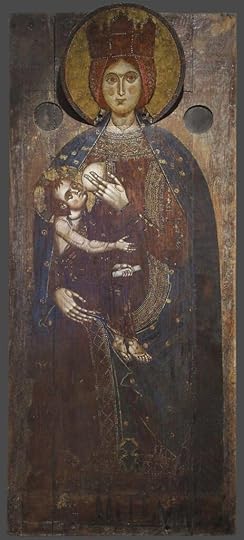 Madonna di San Gugliemo, 12th century (Sienna, Italy). This depiction of the “Madonna Lactans” (Nursing Madonna) is a eucharistic image as much as it is an image of a mother caring for her child. Read more about this type of image here and see more examples here.
Madonna di San Gugliemo, 12th century (Sienna, Italy). This depiction of the “Madonna Lactans” (Nursing Madonna) is a eucharistic image as much as it is an image of a mother caring for her child. Read more about this type of image here and see more examples here.And I, brothers and sisters, was able to speak to you not as spiritual people but only as carnal people, as infants in Christ. I gave you milk to drink, not substantial food, because you were not yet capable, nor are you capable until now, for you are fleshy people. (1 Cor. 3:1-3)
In the ancient world, milk-blood-semen were all thought to be the same liquid but warmed to differing temperatures by different internal organs. Blood was the coldest of these and the basic, most natural form of this liquid. Milk was blood, warmed and made frothy in a woman’s breasts. Semen was blood, made even warmer and frothier in a man’s testes. According to this biological idea, when a mother was nursing her child, she was feeding the baby with her own blood.
Because blood and milk were identical, the correspondence of the Virgin’s milk and Christ’s blood was important to early and medieval Christians. The Virgin’s blood becomes milk in her breasts; she nurses Christ, feeding him her warm and frothy blood; he drinks this frothy blood, which becomes the blood in his own veins. Medieval images of the Nursing Madonna (Madonna lactans) are fundamentally eucharistic images, celebrating the identity of the Virgin’s milk with Christ’s blood; she feeds him with her body which becomes his Body and he feeds the Church with his Body and Blood in the Eucharist.
There is no more vivid and elaborate exposition of 1 Corinthians 3 in early Christian literature than that found in Clement’s Paedagogus 1.6…. By combining Galatians 3:28 and 1 Corinthians 3, Clement sets the foundation for his argument that all Christians are already spiritual…and, as a result, milk-drinking infants cannot be viewed as equivalent to “carnal” Christians. Rather, milk is the food of all Christians who “seek our mother, the church.”
John David Penniman, Raised on Christian Milk
Not only did a mother’s milk (blood) provide sustenance to her baby, the infant received religious and ethnic formation as well by ingesting his/her mother’s identity via the milk-blood. This is why receiving Holy Communion was so important: to receive Christ’s blood was to be shaped and formed by his identity, according to St. Gregory of Nyssa.
Discover more about this fascinating subject in Raised on Christian Milk: Food and the Formation of the Soul in Early Christianity by John David Penniman (Yale University Press, 2017).
The post Spiritual Milk appeared first on Stephen Morris, author.
February 7, 2022
Demonstrative Proof

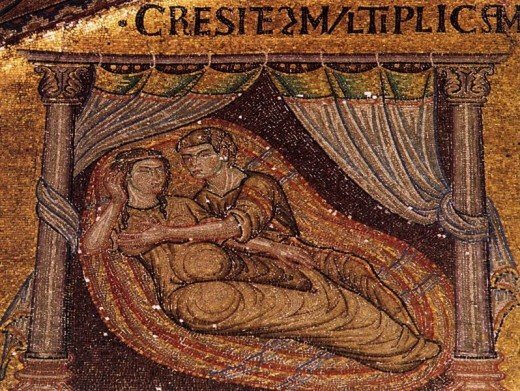 Adam and Eve, a mosaic in the Basilica of San Marco in Venice, Italy, was created between 1200 and 1250. On the left, the Word of God (the Last Adam) prepares to fashion Eve from the first Adam’s rib; on the right, Adam knows his wife Eve.
Adam and Eve, a mosaic in the Basilica of San Marco in Venice, Italy, was created between 1200 and 1250. On the left, the Word of God (the Last Adam) prepares to fashion Eve from the first Adam’s rib; on the right, Adam knows his wife Eve.And I came to you, brothers and sisters, not with the advantage of rhetoric and wisdom …. not with persuasive words of wisdom but in the demonstrative proof of the Spirit and power. (1 Corinthians 2:1, 4)
St. Paul reminds the Corinthians that he did not preach to them and among them with fancy words and Greek philosophy but simply, relying on the Spirit of God to demonstrate the power and truth of his words. His sermons wouldn’t win an oratory prize, he says. But his sermons did win their hearts.
A third-generation Christian bishop, Irenaeus of Lyons, wrote a Demonstration of Apostolic Preaching to accomplish the same thing that St. Paul was aiming for: teaching or reminding new converts the basic Christian understanding of the world and how to relate to it from a Christian perspective. His other famous work, Against Heresies, refutes the teachings of several different heretical sects that claimed to be Christian; in both works, St. Irenaeus establishes fundamental principles of theology and biblical interpretation that still guide Christian readers and thinkers.
Irenaeus was born in Smyrna. He was taught the Faith by St. Polycarp, who had been taught by the Apostle John. In the Demonstration, St. Irenaeus reviews salvation history in the Old Testament and then cites several Old Testament prophecies about the Messiah, explaining how Christ fulfilled them. St. Irenaeus writes
This, beloved, is the preaching of the truth, and this is the manner of our redemption, and this is the way of life, which the prophets proclaimed, and Christ established, and the apostles delivered, and the Church in all the world hands on to her children. This must we keep with all certainty, with a sound will and pleasing to God, with good works and right-willed disposition.
One of St. Irenaeus’ most interesting ideas is that of “recapitulation,” in which he teaches that Christ and his mother summarize and set right everything that went wrong with Adam and Eve; he points out that Christ is the Second (Last) Adam and Mary is the Second Eve:
For in what other way could we have partaken in the adoption of sons, unless we had received from him [God the Father] fellowship with himself through the Son? Unless his Word, having been made flesh, had entered into fellowship with us?
For this reason, he also passed through every stage of life, restoring fellowship with God to all [stages of life]….
The human race fell into bondage to death by means of a virgin, so is it rescued by a virgin; virginal disobedience having been balanced in the opposite scale by virginal obedience. For in the same way the sin of the first created man received amendment by the correction of the First-begotten, and the coming of the serpent is conquered by the harmlessness of the dove, those bonds being unloosed by which we had been fast bound to death.
St. Paul and St. Irenaeus both want to demonstrate how God has acted in the past to save his people and how God continues to act in the lives of his chosen. Those who have experienced God’s acts of deliverance are called to demonstrate this by responding appropriately. Most of the rest of the first letter to the Corinthians is about what this demonstrative response to God appropriately looks like.
The post Demonstrative Proof appeared first on Stephen Morris, author.
February 1, 2022
Register for Online Talk

I’m giving a talk for the Church Club of NY on February 15, 2022 at 6:30 p.m. on “East and West: Lent, Bread, and Purgatory—plus the Filioque!”
Register for a free spot in the Zoom audience here
The post Register for Online Talk appeared first on Stephen Morris, author.
January 31, 2022
“Was Paul Crucified for You?”
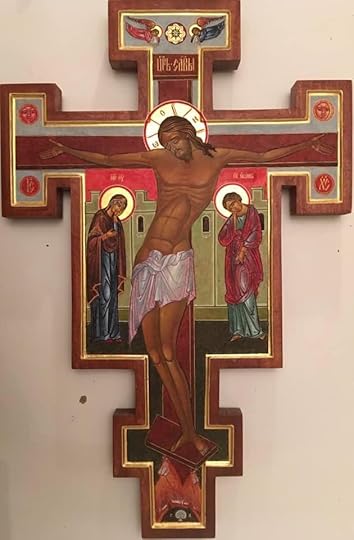 A Byzantine style icon of Christ crucified, with Adam’s grave in the hill beneath the Cross as St. John the Divine and the Mother of God stand on each side of Christ. The sun, moon, and angels are aghast at what they see happening on Golgotha. Christ’s eyes are closed, his body slumped against the Cross, and the footrest beam twisted diagonally which all indicate that Christ is already dead.
A Byzantine style icon of Christ crucified, with Adam’s grave in the hill beneath the Cross as St. John the Divine and the Mother of God stand on each side of Christ. The sun, moon, and angels are aghast at what they see happening on Golgotha. Christ’s eyes are closed, his body slumped against the Cross, and the footrest beam twisted diagonally which all indicate that Christ is already dead.…each of you says, “I am of Paul,” or “I am of Apollos,” or “I am of Cephas,” or “I am of Christ.” Is Christ divided? Was Paul crucified for you? Or were you baptized in the name of Paul? (I Cor. 1:12-13)
The parish in Corinth was torn apart by various factions, each claiming to be faithful to a different Christian teacher who was prominent or famous in one way or another. How did these factions differ? What did they teach that put them in opposition to each other?
The names of the teachers that each faction claimed to be faithful to are probably familiar. “Cephas” was the Apostle Peter. Apollos was a well-educated Jewish man from Alexandria (Egypt) who was “mighty in the Scriptures” (Acts 18:24) who knew something of Christ but was really taught everything he knew about Christianity by Priscilla at Ephesus (Acts 18:26); he was eventually made the first bishop of Crete (Titus 3:13).
We know that Peter and Paul had intense disagreements about how much of Jewish practice should be embraced by Gentile converts to Christianity. Priscilla and Apollos were dear co-workers with the Apostle Paul; how much could they have disagreed with each other?
If we read the New Testament carefully, we discover that there was not a simple dichotomy between “Jewish Christianity” vs. “Gentile Christianity.” There seem to have been four distinct styles of Christianity with four differing sets of what should be expected from Gentile converts.
Group One insisted that Gentile converts observe the whole Mosaic Law, including circumcision. The missionary work of this group (the “false brothers” of Galatians 2:4) was deeply antagonistic towards St. Paul.
Group Two did not insist on circumcision but did require Gentile converts to keep certain practices of the Mosaic Law (esp. kosher food). We see this reflected in the council described in Acts 15. This group looked to the Apostle Peter [Cephas] and St. James, the “brother of the Lord,” as their leaders.
Group Three did not require circumcision or other practices of the Mosaic Law (kosher food) but did see them as having a certain ongoing value, nevertheless. This seems to have been the group most reflective of the Apostle Paul’s own attitude.
Group Four did not require circumcision or other practices of the Mosaic Law (kosher food) and saw no abiding significance or value in Jewish cult or feast days. These views were more radical than those of the Apostle Paul and seem to be reflected in the sermon of St. Stephen (Acts 7), who insisted that God does not dwell in the Temple and refers to Mosaic Law as “your law” and “their law.”
The factions in Corinth seem to reflect these basic distinctions. As St. Paul discusses the problems in Corinth, we see how the factions are rooted in these differing attitudes toward Jewish practice and expectations of Gentile converts to the Church.
For more about these differing groups of “Jewish Christianity” see Antioch and Rome: New Testament Cradles of Catholic Christianity by Raymond E. Brown and John P. Meier. (Paulist Press. 1983, 2004)
The post “Was Paul Crucified for You?” appeared first on Stephen Morris, author.
January 24, 2022
And the winner is….!

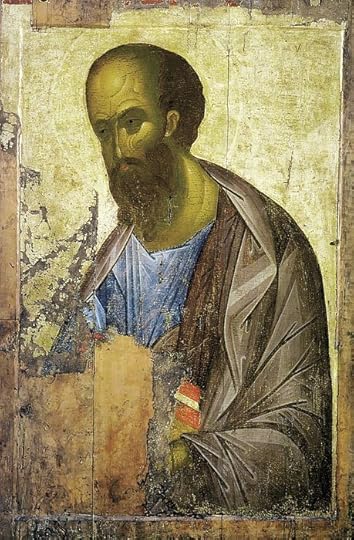 Two icons of the Apostle Paul: on the left, a contemporary icon in classic Slavic style; on the right, an icon painted by St. Andrei Rublev in 1400s Russia. The apostle is always depicted with a large forehead and receding hairline (bald spot) but with dark hair and beard. He looks similar in many ways to icons of St. John Chrysostom–except the apostle’s beard is longer!–because both were famous as powerful preachers … who both had voices that were reportedly difficult to listen to!
Two icons of the Apostle Paul: on the left, a contemporary icon in classic Slavic style; on the right, an icon painted by St. Andrei Rublev in 1400s Russia. The apostle is always depicted with a large forehead and receding hairline (bald spot) but with dark hair and beard. He looks similar in many ways to icons of St. John Chrysostom–except the apostle’s beard is longer!–because both were famous as powerful preachers … who both had voices that were reportedly difficult to listen to!This is not a democracy! Remember? I said that last week about the selection of the topic for my next series of blog posts. I am interested in what my readers would like to read but the final decision has to be mine.
I presented three choices and was greatly surprised by the results! Far and away, the most frequently requested topic was First Corinthians! I expected Genesis to be the most popular and Romans to probably be a close second. But I was wrong. Many MANY more readers are interested in First Corinthians than in either Genesis or Romans, combined! Which is not to say that I won’t write about Romans or Genesis in the future but I will bow to the pressure of popular, public opinion and begin a series of posts on the Apostle Paul’s first epistle to the Corinthians!
A few words to set the stage:
St. Paul evidently wrote at least four letters to the parish at Corinth; we only have two of them (1 Cor. 5:9, 11; 7:1). In 1st Corinthians, he says that he is writing in response to a letter they had already sent him. (Some people think that 2nd Corinthians is a mash-up of two separate letters, which means we have three of the four letters he sent.)
First Corinthians is the longest ancient Hellenistic (Greek language, culture, and style) letter that we have. Hellenistic letters were usually dictated to a scribe or secretary; they were often not read by the recipient, but the recipient listened to another secretary read the letter aloud when it arrived. They were not “signed” at the end; the author identifies himself at the beginning of the letter.
There were three typical styles of writing a Hellenistic letter. A forensic letter, which was about the past and aimed to move the readers-listeners to make a judgement; this was similar to a speech in court. A demonstrative letter was about the present and aimed to move the readers-listeners to assign blame or praise; this was similar to a speech at a funeral or a wedding. A deliberative letter is about the future and aims to move the readers-listeners to make a decision and act accordingly; this was similar to a speech in a political assembly. First Corinthians is written in the deliberative style, aiming to move the Corinthians to make some decisions and act accordingly.
In Hellenistic writing, a “friendly” letter was usually written by someone in a position of authority to those who owed him some kind of obedience or allegiance. First Corinthians is a “friendly” letter; St. Paul addresses the Corinthians as “my brothers and sisters” at least 20 times! So, this letter is a friendly, deliberative letter that wants the readers to behave in a way that fosters unity rather than division.
First Corinthians was written in approx. AD 59 while St. Paul was in Ephesus (Acts 20:31). It is one of the oldest New Testament texts that we have; there is a papyrus copy written in AD 200 in a museum near Dublin.
Next week: chapter one!
The post And the winner is….! appeared first on Stephen Morris, author.
January 17, 2022
Genesis? Romans? Or First Corinthians?
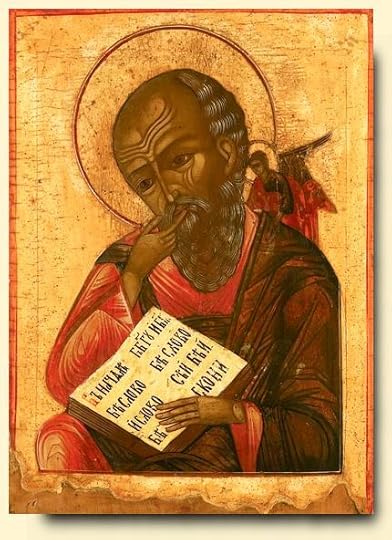 This 19th century Russian icon, known as the “Apostle John the Theologian in Silence,” shows the apostle contemplating the beginning verses of his gospel: “In the beginning was the Word….” Any icon of St. John which shows his fingertips on his lips– like a librarian saying, “Shhhh!”–is a warning to keep silent when approaching God if we hope to begin to understand even a little of divine revelation. Which biblical book should we begin to quietly contemplate next week?
This 19th century Russian icon, known as the “Apostle John the Theologian in Silence,” shows the apostle contemplating the beginning verses of his gospel: “In the beginning was the Word….” Any icon of St. John which shows his fingertips on his lips– like a librarian saying, “Shhhh!”–is a warning to keep silent when approaching God if we hope to begin to understand even a little of divine revelation. Which biblical book should we begin to quietly contemplate next week? Which is it to be? I am thinking about my next series of blog posts. Too many choices! But I have narrowed the selections down to three possibilities–a series about the book of Genesis, or about the epistle to the Romans, or the first epistle to the Corinthians.
That’s quite a short list, isn’t it?! It’s traditional to begin reading the book of Genesis in the post-Epiphany season and continue reading it until Holy Week approaches. So much of Genesis sets the stage for the drama of redemption in Jerusalem that our understanding of Christ’s Passion-Death-Resurrection can only be enhanced by understanding more about the book of Genesis.
Romans is always interesting–and frequently controversial. Many theological debates and battles have been sparked by someone reading a portion of Romans, sharing their insights, and someone else arguing, “That’s not what it means!” Struggling with Romans is to struggle with some of the most basic and yet sophisticated theological ideas.
Then there is the first epistle of St. Paul to the Corinthians. Corinth was a cesspool of a city in the first century; a friend recently described it as “the Las Vegas of the first century!” The first Christian parish there had many difficulties, reflecting the difficulties in the city. There were several letters from church leaders to the parish in Corinth in the first two centuries, each urging the Corinthian Christians to get their act together! St. Paul’s first epistle to the Corinthians is the first salvo in that series of epistles that attempt to deal with the problems in Corinth.
Which series would my readers be most interested in? What do you want to read a series of blog posts about? This is certainly not a democracy–I will make the final decision! But I am interested in knowing what you–my readers–think. Let me know which series you might be most interested in reading. Then see which one begins next week.
Or do you have another idea for a different series altogether? Let me know!
The post Genesis? Romans? Or First Corinthians? appeared first on Stephen Morris, author.
January 3, 2022
Top Blog Posts of 2021

What were the top posts here during the last year? Which posts did the most people read? Here’s the Top 10 list of 2021… do some sound familiar? It’s because so many people read them–maybe even you! Click the links to read the ones you might have missed.
Doubting Midwife on November 29–read it again
Was Christ Born at Midnight? on December 20–read it here
Nativity of Christ in Early Christian Literature on November 29–read it again
Presentation of the Virgin on December 6–read it here
Angels and Deacons on March 22–read it again
Woman Clothed with the Sun on June 7–read it here if you missed it
666 is the Number of the Beast on June 22–read it again
Whore of Babylon on August 2–read it here
Satan Bound for 1,000 Years on August 30–read it here if you missed it before
Religion Pure and Undefiled on October 19–read it again
Keep your eyes peeled for the new posts coming in 2022! (Some readers might be asking, “If these were the most popular posts of this past year, what was the most popular post ever in the history of the blog?” This was the all-time most read post ever.
The post Top Blog Posts of 2021 appeared first on Stephen Morris, author.
December 20, 2021
Christ Was Born at Midnight?
 Byzantine mosaic from Palermo, circa 1150
Byzantine mosaic from Palermo, circa 1150 For while all things were in quiet silence, and the night was in the midst of her course, Thy almighty Word leaped down from heaven from thy royal throne, as a fierce conqueror into the midst of the land of destruction, with a sharp sword carrying thy unfeigned commandment, and he stood and filled all things with death, and standing on the earth, reached even to heaven. (Wisdom 18:14-16)
St. Luke tells us that there were shepherds in the field at night who were told by angels that Christ had been born. But the Gospel does not say that Jesus was born at night. Many readers simply assume that the angel appeared to the shepherds at night as Christ was being born. But that is not explicitly stated in the Gospel. The idea that Christ was born at midnight developed over time and was especially influenced by this text from the Book of Wisdom.
The passage from Wisdom is describing the Word coming down to slay the firstborn of Egypt at the time of the Exodus. The Word comes to redeem the Chosen People, slaying their enemies and leading them from bondage and death into freedom and life. This text was understood by the early Christians as also referring to the descent of the Word into Hell on Holy Saturday to destroy Death and Hell, leading the human race to salvation and life. This descent into Hell and Resurrection was the focus of the Easter Vigil. Over the centuries, the celebration of Easter Eve influenced the celebration of Christmas Eve and the descent of the Word at midnight was applied to Christmas as well as Easter.
Some early Christians did think that Christ was born at midnight even before this became a common idea influenced by the Wisdom passage. The Protoevangelium in the second century describes Christ’s birth at night and how the newborn baby filled the stable-cave with light that was so bright Joseph and the midwives he had gone to find could not enter the cave when they arrived. Gradually, as the light faded, they saw that Christ had been born already and was nursing at his Mother’s breast.
There was always brilliant light when God appeared in the Old Testament. Moses could not enter the Tent of Meeting because the light of God’s glory was too bright. (Exodus 40:35) The priests could not enter the Temple to serve when Solomon dedicated it because the light was too bright. (1 Kings 8) Many Christmas cards show beams of light shining from the manger and we sing about the bright beams of light from Christ’s face in Christmas carols.
Christ’s life begins and ends in a borrowed cave–the stable and the tomb. The light shines in the darkness when the Word descends at night into that stable and even to the dark depths of Hell to save the world. God’s activity to save–whether at the Exodus, at the Nativity, or at the Death and Resurrection–is always the same: he comes down to where we are and finds us there, no matter how dark that place is.
The post Christ Was Born at Midnight? appeared first on Stephen Morris, author.
December 13, 2021
Doubting Midwife

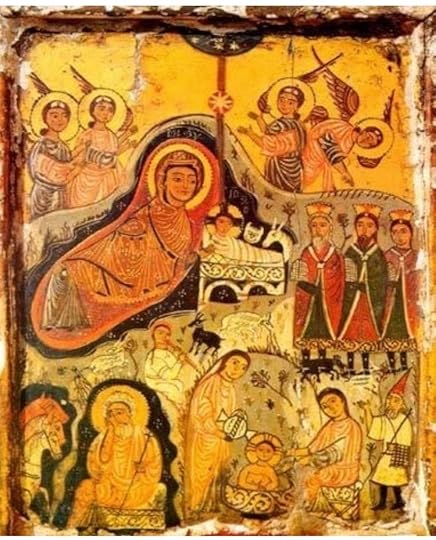 In these icons of the Nativity (on the left, a 12th century fresco from Cappadocia; on the right, a Coptic icon), we see the newborn Christ being washed by the midwives (lower right corner of the Coptic icon). In many depictions of the midwives washing the newborn Christ-child (as above), the cistern or tub they use looks similar to the paten on which the Holy Bread is offered in the Eucharist to become the Body of Christ. Jesus as identified as the Lamb of God offered to the Father from the moment of his birth. In the Coptic icon, we also see the shepherds around the midwives watching a flock of white sheep and black goats–the righteous and the sinners Christ is born to save.
In these icons of the Nativity (on the left, a 12th century fresco from Cappadocia; on the right, a Coptic icon), we see the newborn Christ being washed by the midwives (lower right corner of the Coptic icon). In many depictions of the midwives washing the newborn Christ-child (as above), the cistern or tub they use looks similar to the paten on which the Holy Bread is offered in the Eucharist to become the Body of Christ. Jesus as identified as the Lamb of God offered to the Father from the moment of his birth. In the Coptic icon, we also see the shepherds around the midwives watching a flock of white sheep and black goats–the righteous and the sinners Christ is born to save.“Doubting midwife?” Where did she come from? There is no mention of a midwife in Matthew’s or Luke’s account of Christ’s nativity. This woman is the “Doubting Thomas” of the Nativity cycle.
According to the Protoevangelium, Joseph brings the Blessed Virgin to Bethlehem but as there is “no room at the inn,” he settles her in a stable–a cave, not a barn–as her labor begins. He goes to find midwives to assist in the birth.
Joseph quickly finds a pair of local midwives and brings them back to the stable-cave but none of them can enter because of the brilliant light shining within. As the light gradually fades, they are able to see the Virgin and the newborn baby. They enter and begin to tend to mother and child.
The first midwife washes and examines the new mother and is startled to discover that Blessed Mary is still a virgin. She reports this to the other midwife who doubts this and reaches out to examine Blessed Mary herself. But her hand withers as it nears the Virgin’s birth canal and even feels as if it were burning. She quickly withdraws her hand but it remains paralyzed and withered; as she struggles to assist in washing the newborn baby, she is healed by touching the child or by the water splashing from the tub–different versions of the story report both styles of healing. This second, doubting midwife proclaims that the new mother is indeed still a virgin and that the miraculous withering-healing of her hand is the sign of this and the miraculous nature of the new baby.
The midwife–who is eventually identified as Salome, possibly the same Salome that brings myrrh to Christ’s tomb with Mary Magdalen–has the same experience as Moses at the burning bush. Moses’ hand withers and is struck with leprosy because he asks for proof that it is truly God who is speaking to him. Isaiah is purged by a burning coal from the heavenly altar, just as the midwife’s hand feels as if it is burning. The midwife exclaims, “Woe is me! Because of my lawlessness and unbelief!” just as Isaiah exclaimed, “Woe is me! I am a man of unclean lips and I dwell among a people of unclean lips!” The midwife’s healing is also an allusion to the healing of the woman with the 12-years issue of blood who is healed simply by touching the hem of Christ’s garment in the crowd.
Just as the Apostle Thomas says he will not believe that Christ is risen unless he touches the wounds in Christ’s hands and side, the midwife cannot believe the report of the first midwife unless she also touches the evidence of the miracle. The disbelief of the apostle and the midwife is healed by touch; both Thomas and Salome testify to the truth of God’s action in the world because they have handled the evidence themselves.
Why is it important that the Mother of God remain ever-virgin? Her perpetual virginity is a safeguard of our status as brothers and sisters of Christ; if she had other biological children who were biological relatives of Christ, it would relegate Christian believers to second-rank status in the Church. Some members–the biological relatives–would be MORE the “brothers and sisters of Christ” than other believers who were not biological relatives. In order to avoid this two-tier system in the Church and to prevent a dynasty of Christ’s relatives from ruling the nascent Christian community, it was important that Mary have no other biological children. (We see in the Gospels themselves that she had no other children or Christ would not need to commend her to the care of St. John, the Beloved Disciple, at the Crucifixion. Those people the Gospels refer to as Christ’s brothers and sisters were his cousins or stepbrothers and stepsisters, the children of Joseph’s first marriage.)
Read my prior post about the stable-cave in which Christ was born here.
Read my prior post about the goldfinch often seen in portrayals of the Virgin and Child here.
The post Doubting Midwife appeared first on Stephen Morris, author.
December 6, 2021
Presentation of the Blessed Virgin
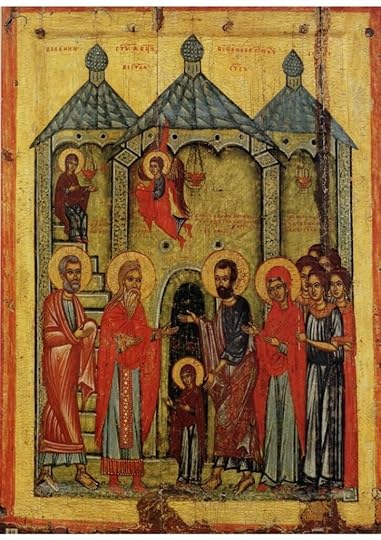 In this Georgian icon, we see the Blessed Virgin presented to the priests in the Temple by her parents SS. Joachim and Anna with the young girls who also marched with her in procession; above, we see the archangel Gabriel bringing the Virgin bread from heaven. The Presentation of the Virgin is celebrated in East and West on November 21.
In this Georgian icon, we see the Blessed Virgin presented to the priests in the Temple by her parents SS. Joachim and Anna with the young girls who also marched with her in procession; above, we see the archangel Gabriel bringing the Virgin bread from heaven. The Presentation of the Virgin is celebrated in East and West on November 21.We read of the Presentation of the Virgin in the Temple when she was three years old in the Protoevangelium of James. SS. Joachim and Anna bring their daughter Mary to the Temple, as they promised to do before she was born, and give her to the service of God. Seven pairs of young girls march in procession with Mary. The priests meet this procession and take Mary into the Temple–into the Holy of Holies!–to live; she joins a community of women who care for the Temple fabrics and vestments. The archangel Gabriel brought the Blessed Virgin bread from heaven each day. When she was older, she was chosen to assist in weaving a new veil to hang before the Holy of Holies; it was while she was working with the purple thread to be used in the weaving that Gabriel appeared to her one last time, asking her to become the mother of Jesus (the Annunciation).
The two things in the story that usually strike people as outlandish or impossible is the assertion that the Blessed Virgin enters the Holy of Holies itself and that she grows up at the Temple, cared for a community of woman in the Temple compound.
The Virgin is said to enter the Holy of Holies because she herself becomes the Holy of Holies–the innermost sanctuary where God dwells. Clearly, it would have been impossible for a three-year old to “accidently” enter the Holy of Holies as it was heavily guarded and protected; the Holy of Holies here stands for the Temple itself in its entirety as well as its being synonymous with the Virgin herself.
The community of women who live at the Temple is alluded to by St. Luke in his Gospel by the Prophetess Anna (in Luke 2), an elderly woman who meets Christ in the Temple when he is forty days old. But the story in the Protoevangelium still strikes many as unlikely. Throughout the Old Testament we read of women who waited at the door of the Temple or the Tent of Meeting in the wilderness (Exodus 38:8; Numbers 4:23, 8:24; 1 Sam. 2; as well as 2 Maccabees 3).
We have also recently made archeological discoveries that reveal the presence of a 3-story women’s dormitory alongside the Temple and we read in Josephus (an important 1st century historian) that the young women and their chaperones made a Nazarite vow and who lived in this dormitory; he also tells us that these young women (virgins) jumped out of the windows into fires below to avoid being attacked, raped, and killed by the Roman soldiers who pulled down the Temple in AD 70. Jewish sources–such as the Mishnah and the Talmud–tell us that a community of women were, in fact, responsible for the care of Temple linens as well as baking the showbread and mixing the incense to be used.
That the Virgin is presented when she is three-years old relates to the expectation that children were weaned at that age and the prophet Samuel was given to the priest Eli when the boy was three-years old. Heifers and other animals to be sacrificed were also three-years old when given as offerings to God. The archangel Gabriel is said to bring her bread from heaven because she eventually gives birth to the Living Bread, the True Bread come down from heaven. In the meanwhile, she is sustained by a rich life of prayer and devotion to God.
The story of the Presentation of the Virgin makes the point that the two most important signs of the Old Covenant become flesh in the New Covenant: the Torah–the living Word of God–is made flesh in Jesus and the Temple–the place where God dwells and where people can meet him–becomes a woman. The Protoevangelium recalls many details of 1st century Jewish life that were otherwise forgotten for centuries and is more reliable as a source than many people realize.
The post Presentation of the Blessed Virgin appeared first on Stephen Morris, author.



